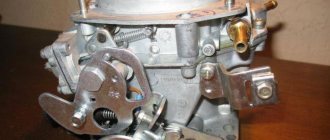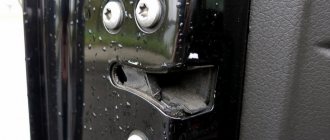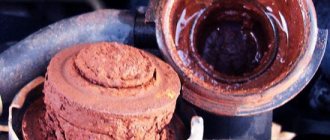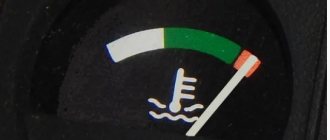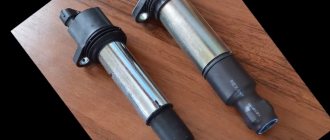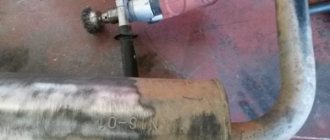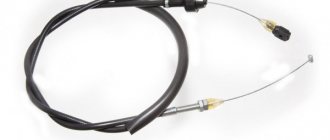When to clean the carburetor
Unfortunately, the fuel we put into the tanks of our cars is not always of high quality. Dirt, corrosion products and water are essential components of any gasoline purchased at our gas stations. They are the cause of contamination of the unit.
Signs of a blockage
Symptoms indicating that the carburetor is clogged include:
- difficult starting of the power unit;
- failures when sharply pressing the gas pedal;
- malfunction of the engine in idle mode;
- increased fuel consumption.
The carburetor becomes dirty not only from the inside, but also from the outside.
But here it is necessary to take into account that the listed signs may indicate other malfunctions, both in the fuel system and in the ignition system. However, if the unit has not been serviced for more than a year, cleaning it will not be unnecessary. Additionally, before starting work, it is recommended to replace the fuel filter in order to be sure that after servicing the device will receive purified gasoline.
Rinse or blow out: which is better?
A carburetor is a complex and precise device consisting of many parts. To remove contaminants inside some of them, washing alone will not be enough. Yes, the body and lid can and should be washed, and if necessary, also cleaned.
With small details things are a little different. Let's take, for example, jets with their channels with a diameter of no more than 2 mm. You are unlikely to be able to wash away the dirt from there at home. The best option here would be to blow out the channels with a stream of compressed air. But it’s better to do this after these parts have soaked a little in one of the liquids that helps dissolve the dirt.
It is also recommended to soak large items before washing and cleaning.
Niva 21213 carburetor. How to clean?
For Niva lovers! This section of the auto forum is intended to discuss a variety of models that are produced under the Niva brand (Niva 2121, Niva 2129, Niva 2131, Chevrolet Niva). Here you will find detailed reviews about these models.
Everyone knows that the quality of our gasoline leaves much to be desired! Somehow the traction on my car has disappeared(((I’m sinning with the carburetor! There is an idea to clean it completely! Who has already done such a procedure - tell me how best to do this, where to start and how to finish? Merzkij Messages: 5 Registered: February 17, 2013 , 14:35 Reputation: 0
To clean it well, it will take a lot of time, you need to completely remove it, disassemble it in detail and wash it in gasoline, all the parts need to be washed well, then you need to blow out all the jets and all the holes with a compressor, wait until it dries well and you can put it on the car, that’s how everything...=)
PrizracniyGonshik Posts: 15 Registered: 05 Mar 2013, 13:06 Reputation: 0
Cleaning it is not a problem, as with any carburetor car... The most important thing is to rinse everything thoroughly, then use a compressor to thoroughly blow out all the jets and holes, everything that is unnecessary will fly out =)) Wash only with gasoline, and nothing else...
Shurik Messages: 21 Registered: Mar 10, 2013, 07:37 pm Reputation: 0
Yes, I agree, gasoline and only gasoline will help you) it’s called what we fill it with and clean it))) So I think you won’t have any difficulty disassembling it - blowing and rinsing is also not such an abstruse job. Once done, we put it back and fill it with normal gasoline.
hiler Messages: 9 Registered: May 20, 2013, 12:29 Reputation: 0
Return to Club - Niva forum
- 5 9841
- 0 1411
- 4 5769
- 2 1642
- 3 1585
Who is currently at the conference
Currently viewing this forum: no registered users and guests: 4
autonew.biz
Washing methods and products used for it
There are three ways to flush the carburetor yourself:
- without removing the engine or disassembling it;
- by partial disassembly;
- by complete disassembly.
The first option involves adding chemically active liquids (additives) to the fuel. In other words, you need to pour a certain amount of cleaning agent into the tank and continue driving your car quietly, without wasting your time. Gasoline with an additive, moving through the fuel system, will itself dissolve and remove dirt. Of course, this method cannot be called effective, and everything that we tried to get rid of will inevitably end up in the engine cylinders.
To flush the carburetor without dismantling it, special additives are used
Flushing the carburetor by partial disassembly is the most popular type of maintenance. We will have to remove the air filter, cover, remove all elements that may be dirty, wash them and put the device back together. The efficiency of this method is quite high, and we can visually determine how clean the unit has become.
To flush, you will need to remove the air filter and carburetor cover.
Well, if you remove and disassemble the device completely, soak all its parts in cleaning liquid, and then rinse them manually and blow them with a stream of air, we will get a practically new carburetor.
Not so long ago, car owners cleaned the carburetors of their cars using liquids that can usually be found at home:
- refined gasoline;
- kerosene;
- diesel fuel;
- solvent.
Yes, they do a good job of removing various types of dirt and deposits on the internal walls of the device, especially if you have the opportunity and time to soak the necessary parts in them for a while. But today there is no need to use such means. It is better to purchase a special liquid from a car store. There are products on sale for both self-cleaning of the fuel system (filling the tank) and for servicing carburetors. The most popular and effective of them are:
- Hi-Gear is a line of products for flushing the fuel system and carburetor. It has high dissolving abilities. Does not harm system elements. Available both in the form of additives and in the form of an aerosol;
Additive "Hi-Gear" for filling into a car tank
- Mannol Vergaser Reiniger is an aerosol carburetor cleaner.
Used for cleaning carburetors and injectors. Copes well with soot, oily deposits, and other contaminants; Carburetor cleaner "Mannol Vergaser Reiniger" - Jet 100 Ultra is a spray for quick cleaning of carburetors. It has the same properties, however, it acts faster.
Aerosol “Jet 100 Ultra”
Adjusting the carburetor on a VAZ Niva car
Created several decades ago, Niva is still popular among domestic and even foreign motorists. This SUV is in demand due to its unpretentiousness, maintainability and good cross-country ability, which can be the envy of many modern cars of the same class. But proper and uninterrupted operation of even such a durable vehicle can only be ensured with proper and timely maintenance and repair. Therefore, if you are not going to spend money on the services of service station specialists, it is advisable to at least superficially understand the design features of your car. For example, self-adjustment of the carburetor on a VAZ Niva car will allow you to optimize engine performance and reduce consumption at minimal cost.
The VAZ-2121 has become popular due to its cross-country ability, technical reliability and ease of operation and maintenance.
This article will focus on setting up the carburetor on the VAZ-2121 and VAZ-21213 models, as the most prominent representatives of domestic classic SUVs. Niva 21213 replaced its predecessor in 1994, having undergone a number of design changes. First of all, the model acquired a new engine, on which the manufacturer installed a different carburetor. The Niva 2121 used an Ozone carburetor, and owners of the next generation of the SUV were offered a more modern unit called Solex. However, many farmers did not appreciate the innovation due to its increased requirements for the quality of gasoline and often resorted to installing the unit from the previous model themselves. You will learn further about how to set up the carburetor on Niva 21213.
How to adjust the carburetor on a VAZ Niva car
How does the Ozone carburetor work on the Niva 21213 and 2121, as well as other classic cars of the VAZ family? From the fuel tank, gasoline enters the float chamber in the appropriate quantity. Next, passing through the nozzle, the atomizer in the diffuser, the fuel is mixed with air. After this, depending on the degree of opening of the throttle valve, a certain amount of the air-fuel mixture is supplied through the intake manifold to the engine cylinder.
Adjustment of the Niva 21213 carburetor is resorted to in cases where it has been repaired, disassembled/cleaned, and when starting the engine is difficult or its operation is unstable. Some types of adjustments can be made without removing the unit from the machine, but in some cases, for example, when you need to adjust the starting device, dismantling is indispensable.
Throttle Actuator Settings
The main goal of adjusting the VAZ-21213 carburetor by adjusting its drive is to ensure the optimal throttle position for the extreme positions of the gas pedal. So, when the pedal is pressed all the way, the throttle should open completely and, conversely, as soon as you release the gas, it should close. This is achieved by setting the required rod length. To perform the adjustment correctly, follow the steps below:
- Disconnect the drive rod from the bracket located on the cylinder head valve cover.
- Using a key set to “8”, loosen the lock nut and, by tightening/unscrewing the rod end, set the optimal throttle position.
- Now all that remains is to tighten the locknut and install the rod in its place.
Upon completion of the adjustment operations, it is necessary to make sure that the position of the damper actually corresponds to the position of the accelerator pedal. If the desired result is not achieved, repeat the described operations.
Carburetor adjustment begins with adjusting the throttle position
Setting the optimal fuel level in the float chamber
If during maintenance and repair the float or needle valve was replaced, the VAZ-21213 carburetor must be adjusted without fail. Read the step-by-step guide and you can make the necessary settings yourself:
- To adjust, remove the carburetor cover and place it in a horizontal position so that the floats are on top.
- You will need a caliper to measure the distance between the cap gasket and the highest point of each float. The manufacturer's documentation indicates that the optimal distance is 34–35 millimeters. If deviations are found after measurements, set the optimal position. To do this, bend or bend the tongue.
- If, after carrying out control measurements, the obtained values correspond to the norm, you can replace the carburetor cover. But during the process, be careful not to allow the floats to come into contact with the walls of the chamber. If necessary, bend the levers without disrupting the level adjustment height.
This is how the fuel level in the float chamber should be adjusted.
Self-adjustment of the starting device
After disassembly and repairs have been carried out with the replacement of the dampers, it is necessary to adjust the VAZ-2121 carburetor, which involves adjusting the starting device. And also this type of adjustment may be necessary if the engine does not start. To do this, the unit will have to be removed from the intake manifold. Prepare a standard set of tools and follow the procedure described below:
- After dismantling the carburetor, you should immediately check how the dampers work. Turn the choke lever counterclockwise until it stops - in this position the damper should close completely.
- At the same time, the throttle valve must be slightly open. In this case, the gap formed between it and the chamber wall should be 1.1 mm. This is the starting gap - it is this that is adjusted when setting up the starting device. You can measure the gap using a wire of the appropriate diameter.
- Use an "8" wrench to turn the adjusting screw located on the throttle lever. This way you will set the required starting gap.
- In addition, with the choke completely closed, press the trigger rod all the way. This will lead to an increase in the starting gap to 3 mm.
- If there are deviations from the norm, additional adjustments will have to be made. To do this, loosen the locknut of the adjusting screw located on the starter housing. Turn this screw until the desired clearance is achieved. After completing the adjustment, be sure to tighten the locknut.
In order to correctly configure the starter, be careful and strictly follow the sequence of actions described in the manual.
How to adjust idle speed on a Niva with your own hands
Upon completion of cleaning, repair, or in order to adjust the idle speed, it is necessary to adjust the Niva 2121 carburetor, during which you will need a gas analyzer - it is used to monitor the content of carbon monoxide (CO) in the exhaust gases. After you have prepared everything you need, including a standard set of tools, read the instructions and start setting up:
- First of all, before carrying out adjustment operations, warm up the engine and turn on current consumers (for example, headlights).
- If the engine is warm, you need to turn it off, then connect the gas analyzer to the exhaust pipe. Restart the engine.
- Take a screwdriver and, turning the mixture amount screw, set the crankshaft speed to 800–850 rpm. Speed control is carried out using a tachometer.
- Next, using the same screwdriver, you need to turn the mixture quality screw. Based on the gas analyzer data, set the CO content in the exhaust gases within 2.5–3%. Often, after the final adjustment, the engine speed deviates from the norm. You need to make adjustments using the quantity screw.
The blue arrow is the quantity screw, the red arrow is the quality screw.
After properly adjusting the carburetor, your car’s engine will develop the necessary power and operate steadily at idle speed. This will ensure optimal fuel consumption. If, after completing the adjustment, dips are observed at any speed, and starting the engine itself is difficult, then most likely there is a malfunction in the carburetor systems. In this regard, diagnostics and appropriate repairs may be required.
CarExtra.ru
Flushing the carburetor without removing it from the engine and disassembling it
Let's look at the procedure for flushing the carburetor without dismantling it using Hi-Gear HG 3205. We need one can of this liquid (295 ml). In stores it costs about 300 rubles, and is designed for 40 liters of gasoline. One jar is enough for a one-time wash. The application procedure is as follows:
- We head to the nearest gas station.
- Unscrew the fuel tank cap.
- Open the can of washing liquid (it opens like a beer can).
- Using a watering can, pour the product into the tank.
- Fill the tank with gasoline (until full);
- We drive the car until the fuel runs out.
According to the manufacturer, the Hi-Gear HG 3205 additive not only promotes self-cleaning of the fuel system, but also helps:
- make it easier to start a cold engine;
- reduce the toxicity of exhaust gases;
- save fuel (up to 7%).
Maybe, of course, everything is not so colorful, but after driving 300–400 km on this additive, you will definitely notice positive changes in engine performance. To maintain the fuel system and the carburetor in particular, it is recommended to repeat the described procedure every 3000 km.
Setting up the DAAZ 21083 carburetor choke. Video
The carburetor idle speed control valve controls the idle speed of the engine. People often ask why I change or remove the wire from the solenoid valve, but the idle speed works. It’s simple, it means the carburetor idle system is clogged, the engine maintains idle speed thanks to the tightened bolt 3 in the photo above. Usually when the idle system is clogged, but the engine is running, taking fuel for idle from the main carburetor system, or the idle system is not clogged and bolts 1 and 2 are tightened. Usually the engine running at idle, taking fuel from the main carburetor system, does not hold idle speed well, they then increase, then decrease.
It also happens that the idle speeds disappear, usually an unknowing driver increases the idle speeds, and it turns out that the idle speeds start working from the main carburetor system.
Flushing with removal from the engine and complete disassembly
Here we need the same tools and tools.
The order of work is as follows:
- We carry out the work provided for in paragraphs 1–12 from the previous chapter.
- Disconnect the air and throttle valve drive cables from the carburetor.
- Using a 13mm wrench, unscrew the nuts (4 pcs) securing the device to the engine.
- We disconnect the heating block from it by unscrewing the screw with a Phillips screwdriver.
- We unscrew the fuel quantity adjustment screw by hand.
- We do not remove the throttle valves.
- Using a slotted screwdriver, unscrew the fuel quality adjustment screw.
- Soak the carburetor body in kerosene (gasoline, acetone). After this, we clean it with a toothbrush.
It is also advisable to soak the carburetor body in kerosene - Small parts and the carburetor cover are washed and cleaned in the same way as with partial disassembly.
Video: cleaning the Solex carburetor
After assembling the carburetor and installing it on the engine, it is necessary to adjust it.
What's the result?
Taking into account all of the above, it becomes clear that even with the relative simplicity of the design, the carburetor still needs timely additional care. To maintain the cleanliness and performance of the device, some experts recommend cleaning and adjusting the carburetor at least twice a year. It is recommended to do this in the off-season, that is, before the onset of severe frost or heat. This measure allows you to maintain fuel consumption at an optimal level.
If noticeable dips are noted when pressing the gas pedal, then, in parallel with cleaning the carburetor itself, remove the carburetor cover, after which you need to pay attention to the accelerator pump nozzle. This element should be thoroughly cleaned using a carbicleaner; additionally, you can blow it with air under pressure from a compressor.
In other situations, it is better to disassemble and clean the dosing device at the first opportunity. This statement is also true if the carburetor is very dirty for some reason or has never been cleaned before.
Various types of available carburetor cleaning products and compositions, advantages and disadvantages. How to properly clean a carburetor, which cleaner is better.
What does the color of carbon deposits on a spark plug indicate, and why does carbon deposits of one color or another form? How to clean spark plugs from carbon deposits with your own hands, tips.
Why do you need to clean the throttle valve periodically? How to clean the throttle valve, training and adaptation of the throttle valve after cleaning, useful tips.
Refinement and modernization of the carburetor. The main disadvantages of the carburetor injection system and how to eliminate them, settings. Intake manifold tuning.
The main reasons that lead to a lean mixture. A lean mixture on carburetor and injection internal combustion engines, as well as on engines with gas equipment. Diagnostics, repair.
Why is it necessary to clean the fuel pump mesh? When is it better to change and how to clean the fuel pump mesh? How to properly remove the fuel pump, subtleties and nuances.
Is it possible to wash it at home without special products?
If you do not have the opportunity to use special products to flush the carburetor, you can do it without them. To do this, simply soak the necessary parts in kerosene (gasoline, acetone) overnight, and in the morning start cleaning and blowing them. With the right approach, the effect will be no worse. But under no circumstances follow the advice of “experts” who recommend pouring a little acetone into the tank or carburetor to clean the fuel system! Yes, acetone perfectly dissolves and removes dirt, carbon deposits, paint residues and even water. But it also dissolves seals, gaskets, and valves made of plastic and rubber!
As you can see, cleaning the carburetor with your own hands is not at all difficult. The main thing is to have a good cleaning product, the necessary tools and a few hours of free time. And to prevent this process from becoming a habit, fill only high-quality fuel into the tank of your car.
Carburetor for VAZ 2106 and 2107: troubleshooting, do-it-yourself repair, installation, adjustment
How to correctly assess the performance of shock absorber struts
Which carburetor is better to install on Niva 21213
The domestic auto industry, after more than fifty years, continues to firmly hold a leading position in the car markets. The VAZ family has a very reasonable price and is quite easy to maintain.
Huge demand has appeared for the Soviet SUV VAZ-21213, as well as its analogues. This type of VAZ car has achieved enormous success in world motorsport, setting unattainable records. This type of car is very actively exported to European countries and beyond.
Car owners who do not have much experience in servicing this type of car quite often encounter various problems associated with the operation and repair of the Niva. One of these common problems is carburetor repair and replacement.
Many drivers do not know which model is better to choose, how they differ from each other and what to follow when choosing one or the other.
How to install the unit in place
You can assemble and reinstall the carburetor in the same way as you disassembled it, performing all the steps in reverse order.
- The carburetor is installed in its place, the mounting bolts are tightened.
- The pipes through which fuel is supplied are attached. The gas cable is connected to the throttle lever.
- The wiring is attached.
- A vacuum hose is connected to the ignition distributor, and the EPHH limit switches are combined.
- After installing the carburetor, it is adjusted.
Video: installing a carburetor on a VAZ
It is not so difficult to independently remove, disassemble, clean and reinstall the carburetor in the VAZ 2107 and 2106. The main thing is not to be intimidated by the huge number of hoses, valves, parts and dirt and strictly follow the instructions.
Didn't find the information you are looking for? on our forum.
VAZ 2109: cleaning carburetors on your own
The main enemy of any carburetor is dirty, low-quality fuel; due to such fuel, malfunctions occur in its operation during the process of mixing fuel with air, either too much fuel and too little air is supplied, or, conversely, too little fuel and too much air. What negatively affects the operation of the engine in both cases, VAZ 2109 cleaning the carburetor helps solve the problem. You should first make sure that it is dirty; if this is the case, you should not hope that by spraying the product on the outside, without removing and disassembling it, you will get rid of the problem; on a VAZ 2109, flushing the carburetor takes more than five minutes.
